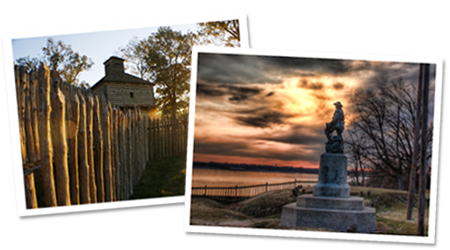
History of the First State Park The site of French, British andAmerican forts and the firststate park in Illinois, FortMassac possesses a richpart of American history. Fort Massac was a fort built bythe French in 1757, originallynamed Fort de L' Ascensionbecause it was started in May1757 on Ascension Day. The fortwas later renamed for the French Minister of Colonial Affairs,Massiac, which was Anglicized into Massac.(1) After the end of the French and Indian War, the fort was more or less abandoned until the American government rebuilt it, strengthening its defenses in 1796.(2) Lewis and Clark passed through the fort on their way to discovering the western frontier.(3) The fort was disassembled in 1814 as local villagers used its lumber and was largely abandoned by the government after the Civil War.(4) Before Fort Massac DAR was founded in 1929, the DAR had a history in Massac county. Two DAR members and sisters with political power in Illinois, Mrs. Letitia Green Stevenson, wife of Grover Cleveland's vice president and former DAR President General, and Mrs. Julia Scott, DAR President General in 1910, lobbied for the creation of a state park with a connection to the American Revolution.(5) The sisters worked with Professor Joseph Cullen Blair, an University of Illinois horticulturist, who was interested in the idea of establishing state parks.(6) He visited the Fort Massac site and took slides to show in lectures that he delivered throughout the state to promote the creation of the state park.(7) Professor Blair found a partnership with the Daughters of the American Revolution in Illinois.(8) Chicago was the site of the first DAR chapter in the nation, and Illinois DAR members joined in lobbying for the creation of a state park because the daughters wanted to mark Revolutionary War sites in Illinois.(9) One of the goals of the DAR was to protect historical locations related to the Revolution, and the Illinois Daughters wanted to preserve a site in Illinois relating to the Revolution because George Rogers Clark had entered Illinois at Fort Massac on his way to capturing the western territories for the colonies.(10) Mrs. Scott commented that "In the east, there are many landmarks of the great struggle that made us a nation. Are landmarks of Illinois' heroic era less sacred than those in other parts of America?"(11) Through their efforts, Illinois made Fort Massac its first state park in 1903 with legislation written by Professor Blair, promoted by Scott and Stevenson, and signed into law by Governor Yates, and in 1908, the fort was dedicated with the late Miss Verna Mae Helm, Fort Massac DAR member and one of the longest living member Daughters, in attendance at the age of 8.(12) The legislation creating the state park gave the Daughters a role in managing it in a time before the creation of state agencies that now manage state land.(13) For fourteen years, the state park was managed by a six-member commission, the Fort Massac Trustees, and the DAR paid for a monument of George Rogers Clark that was dedicated at the same time as the state park and later replaced in 1932.(14) The DAR assisted in managing the park until 1917 when the legislature abolished the special commissions and created administrative departments.(15) "As an association of women devoted to our State and its history and as individuals we will always take an especial interest in it [Fort Massac State Park], not only for its historical associations but because it was the first of the State Parks, the pioneer, and it was secured through the efforts of this Society," Ms. Jessie Palmer Weber, secretary of the Fort Massac Trustees and a member of the DAR, told the DAR annual conference in 1917.(16) In 2003, the Fort Massac DAR and the Illinois DAR rededicated the George Rogers Clark statue, and both groups raised money to replace the marker on the George Rogers Clark statue in the park, successfully completing the project in 2010. Fort Massac is the home of the annual encampment, a re-enactment of colonial life at the Fort held every October.(17) The Fort Massac DAR keeps its connection to the park alive by having its meetings in its visitor's center. Sources:1) Massac County Illinois History, Vol. 1, 1987, Turner Publishing, page 96.2) Ibid. 3) Ibid. 4) Ibid, 97.5) Historic Illinois, Vol. 4, No. 1, June 1981, Illinois Department of Conservation, Springfield, IL (reprinted in Massac County Illinois History, Vol. 1, 1987, Turner Publishing.)6) Ibid. 7) Ibid. 8) Ibid. 9) Ibid. 10) Ibid. 11) Ibid.12) Ibid, http://www.dnr.state.il.us/lands/landmgt/parks/r5/frmindex.htm13) Historic Illinois, Vol. 4, No. 114) Ibid. 15) Ibid. 16) Ibid.17) http://www.metropolistourism.com/content/view/14/116/

National Society
Daughters of the
American Revolution

Welcome to the official site of the
Fort Massac Chapter DAR!
We are Daughters, friends and colleagues and we would love for you to learn more about us. As you explore our site you will find the history of our chapter as well as information about our society.
DAR Fort Massac | IL State Organization | NSDAR | E-mail
Contact the website administrator | This site last updated December 9, 2018 | Fort Massac DAR website designed by Melissa Potterbaum and written by Tracy Douglas | The DAR Insignia is the property of, and is copyrighted by, the National Society of the Daughters of the American Revolution. | Web hyperlinks to non-DAR sites are not the responsibility of the NSDAR, the state organizations, or individual DAR chapters.